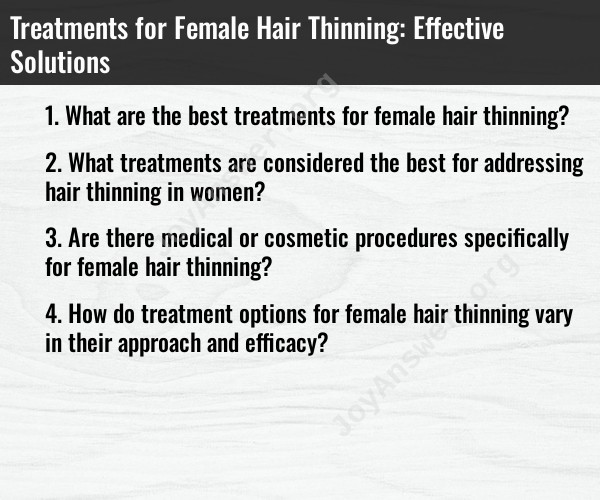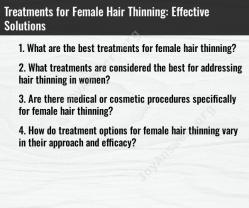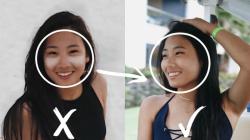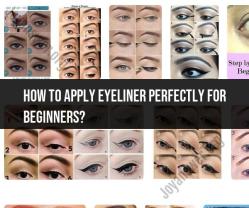What are the best treatments for female hair thinning?
The treatment for female hair thinning can vary depending on the underlying cause. It's essential to identify the cause before determining the most appropriate solution. Here are some common treatments and solutions for female hair thinning:
Consult a Healthcare Professional: Before starting any treatment, it's crucial to consult with a healthcare professional or a dermatologist. They can help identify the cause of hair thinning and recommend a personalized treatment plan.
Topical Minoxidil (Rogaine): Minoxidil is an FDA-approved over-the-counter topical treatment that can help stimulate hair growth. It is available in various concentrations, and some formulations are specifically designed for women. It needs to be applied directly to the scalp, and results may take several months to become noticeable.
Prescription Medications: In some cases, healthcare professionals may prescribe medications such as spironolactone or finasteride to address hormonal imbalances that can contribute to hair thinning.
Low-Level Laser Therapy (LLLT): LLLT is a non-invasive treatment that uses low-level lasers or light-emitting diodes (LEDs) to stimulate hair follicles and promote hair growth. This can be done through specialized devices like laser caps or helmets.
Platelet-Rich Plasma (PRP) Therapy: PRP therapy involves drawing a small amount of the patient's blood, processing it to concentrate platelets, and then injecting the platelet-rich plasma into the scalp. Some studies suggest that PRP may help stimulate hair follicles and promote hair growth.
Nutritional Supplements: Nutritional deficiencies can contribute to hair thinning. Supplements containing biotin, vitamins (particularly B vitamins), iron, and other essential nutrients may be recommended to support overall hair health.
Hormone Replacement Therapy (HRT): For women experiencing hair thinning due to hormonal changes, hormone replacement therapy may be considered. This involves replacing hormones that are in lower levels during menopause, such as estrogen.
Lifestyle Changes: Adopting a healthy lifestyle can positively impact hair health. Ensure a balanced diet rich in vitamins and minerals, manage stress levels, and avoid harsh hair treatments or styles that can contribute to breakage.
Scalp Treatments and Shampoos: Use shampoos and topical treatments specifically designed to promote a healthy scalp. Ingredients such as ketoconazole, saw palmetto, and caffeine are sometimes included in these products.
Wigs and Hairpieces: For immediate cosmetic solutions, wigs, hairpieces, or hair extensions can be used to add volume and cover thinning areas.
It's important to note that results can vary, and what works for one person may not work for another. Patience is key, as many hair treatments take time to show noticeable effects. Additionally, addressing the root cause of hair thinning is essential for long-term success. Always consult with a healthcare professional before starting any new treatment for female hair thinning.
Hair thinning, or female pattern hair loss (FPHL), is a common condition that affects millions of women worldwide. It is characterized by a gradual thinning of hair on the scalp, and can have a significant impact on women's self-esteem and confidence.
There are a number of treatments available for hair thinning in women, each with its own approach and efficacy. Some of the most common treatments include:
Minoxidil (Rogaine): Minoxidil is a topical medication that is applied to the scalp to stimulate hair growth. It is available over-the-counter and by prescription. Minoxidil is most effective for women who have been experiencing hair loss for less than 5 years.
Spironolactone (Aldactone): Spironolactone is an oral medication that is used to treat high blood pressure, but it can also be used to treat FPHL. Spironolactone works by blocking the production of DHT, a hormone that can contribute to hair loss in women. Spironolactone is most effective for women who have androgenic alopecia, a type of FPHL that is caused by genetics.
Finasteride (Propecia): Finasteride is an oral medication that is used to treat male pattern baldness, but it can also be used to treat FPHL in women. Finasteride works by blocking the production of DHT, a hormone that can contribute to hair loss in women. Finasteride is most effective for women who have androgenic alopecia.
Laser hair therapy: Laser hair therapy is a non-invasive treatment that is used to stimulate hair growth. Laser hair therapy works by increasing blood flow to the scalp, which can help to nourish hair follicles and promote hair growth. Laser hair therapy is most effective for women who have been experiencing hair loss for less than 10 years.
Platelet-rich plasma (PRP): PRP is a treatment that uses your own blood to stimulate hair growth. PRP is injected into the scalp to help stimulate hair follicles and promote hair growth. PRP is most effective for women who have androgenic alopecia.
Hair transplantation: Hair transplantation is a surgical procedure that involves moving hair from one part of the scalp to another. Hair transplantation is most effective for women who have lost a significant amount of hair.
In addition to these medical and cosmetic procedures, there are a number of things that women can do to promote hair growth and prevent hair loss:
Eat a healthy diet: A healthy diet that includes plenty of fruits, vegetables, and whole grains can help to promote hair growth.
Get enough sleep: Getting enough sleep can help to reduce stress and promote hair growth.
Manage stress: Stress can contribute to hair loss. Managing stress through exercise, relaxation techniques, or therapy can help to prevent hair loss.
Avoid smoking: Smoking can damage hair follicles and contribute to hair loss.
See a doctor: If you are concerned about hair thinning, see a doctor to get an accurate diagnosis and discuss treatment options.
The effectiveness of hair thinning treatments can vary depending on the individual and the type of hair loss they are experiencing. Some people may see results within a few months, while others may not see any results for 6 months or more. It is important to talk to your doctor to determine which hair thinning treatment is right for you.
I hope this information is helpful. Please let me know if you have any other questions.











